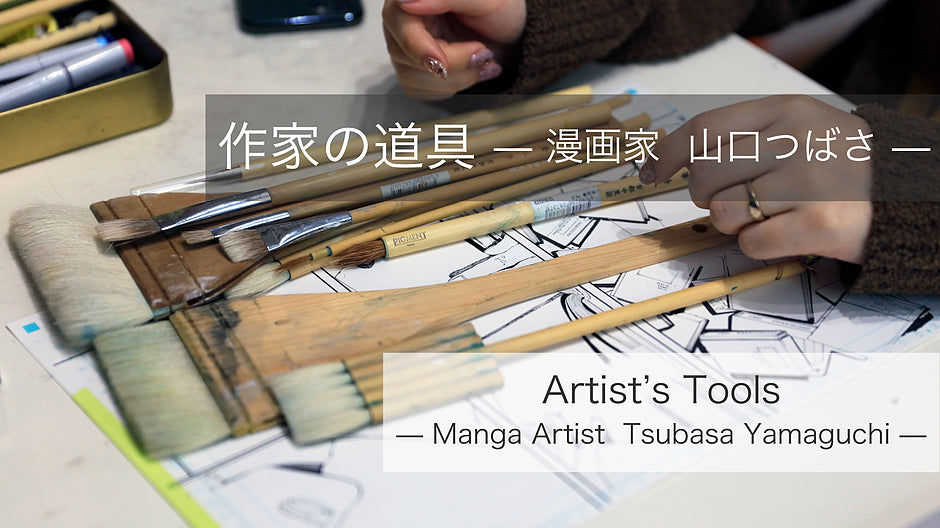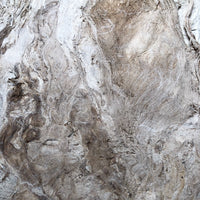Drawing manga is not only about how talented you are, nor is it a path that only an art prodigy can take.
Blue Period is a manga series that depicts there is no wrong answer in art.
It is one of the works that have had a great impact on many fields, from artists to those who were inspired to create art because of the manga.
“*Blue Period Exhibition 〜Art is a Gift〜?” allows visitors to experience the world of the manga through your five senses.
*This exhibition has ended.
The manga artist, Tsubasa Yamaguchi, first visited PIGMENT TOKYO to attend a workshop, and she has been using our paintbrushes since then.
Fan or not, some of you might wonder, how manga artists use their paintbrushes in manga production and how they utilize them in drawing style or texture so the painting could be perfectly rendered in print.
In this article, along with the exhibition, PIGMENT TOKYO visited Yamaguchi’s studio and interviewed about her favorite art materials, tools and the production behind Blue Period.

Tsubasa Yamaguchi photographed at her studio with her pet Bengal eagle owl, Yoru.
— I see that you own quite a few of PIGMENT TOKYO’s brushes.
Tsubasa Yamaguchi (hereafter referred to as Yamaguchi):
That’s right. I tried using brushes from other stores but they didn't feel right. Until I discovered and bought some from PIGMENT TOKYO and they fit like a glove.

This is the desk where all the manga production happens.
As you can see, the traces left on these paintbrushes are evidence of Yamaguchi’s work over time.
—Thank you for your long support.
Do you always use these brushes (like Renpitsu brushes, flat brushes, Sengaki brushes, Kolinsky Yuin Mensho and Sakuyo brushes)? It seems like you have been using them a lot.
Yamaguchi: Yup, these are my favorites.
— It also seems like you prefer larger brushes. Do you often use flat brushes as well?
Yamaguchi: I mostly use flat brushes and Sengaki brush for drawing skins and matte surfaces. I also use a G-pen for sketching lines like outlines.
— I noticed that you also own some rare brushes such as peacock brush, chicken feather brush and Megodake brush.
Rare brushes are very popular at PIGMENT TOKYO and usually sell out in the blink of an eye. It is interesting to see how flexible brushes like the peacock brush and the chicken feather brush produce unique strokes and textures that are different from what you expect.
Yamaguchi: I haven't used these brushes yet because I don't want to ruin the brushes by applying color to them. But they sure look interesting and maybe someday I'll try using them in my work.

—Are there any other painting materials or brushes that you would like to try or that you have a favorite?
Yamaguchi: There are so many things I want to try but it’s not easy to find a new art style, so I haven't tried much at the moment.
To be honest, PIGMENT TOKYO’s brushes always tend to make me so excited!
If I use a bad brush, it changes everything like the style, on the other hand, it is so much easier to paint with a good one and I feel more comfortable like my painting looks better.
— It is true that the state of the brush changes the texture of the lines and drawing.
I remember you first visited PIGMENT TOKYO through a color theory workshop. Are there any new techniques you are interested in or workshops you would like to take?
Yamaguchi: The first thing that comes to mind is that I would like to try Nihonga, the Japanese painting.
I have never done Japanese painting before, so I’ve always been wondering how to do it.
— We provide workshops like Introduction to Mineral Pigments where you can paint with mineral pigments like the Japanese painting technique does, so please do visit us sometime!
Yamaguchi: I would love to attend it! Is there anything else?
— Currently, we are also holding two other regular workshops, which are "Creating Original Paints" by using Suihi (tinted pigments) and “Introduction to Metal Leaf”.
Yamaguchi: Oh, I took that watercolor paint-making workshop before!
Although I studied a little bit of everything when I was in art high school, I haven’t got to learn Japanese painting because the materials and tools seem too complicated to me back then.
Other than that, I also feel like learning more when I work for the manga.
— Right, and there are workshops like “Creating Original Pastels” and “Creating Original Crayons”, although they are just a limited time offer.
Yamaguchi: Oh, that sounds fun! I’m sure it is very interesting to make your own art materials, isn’t it?
— Yes, it is really fun to make art materials.
PIGMENT TOKYO hasn’t been able to do much for the past two years but we do hope that we can hold all kinds of workshops like we used to again.
Yamaguchi: I have the impression that many Blue Period manga fans are also interested in art but have no idea where to start. And I’m sure many people who are reading Blue Period would be interested in workshops too.
— It also seems that many people become interested in oil painting after reading Blue Period.
Yamaguchi: You’re probably right, not like all my readers are applying for the art school, though.
— Matter of fact, we do have some customers who have come to PIGMENT TOKYO because they are preparing to apply to art schools while reading Blue Period or need to buy a nice brush for their exams.
Yamaguchi: I knew it would have a great impact! I’m so happy to hear that students recognize the importance of using good quality brushes.
— I think thanks to this manga, lots of people have been able to learn more about art school and the problems that students face in art-making. I also think that it allows the readers to finally understand that the art school is rather a place where art is created.
Yamaguchi: A parent whose child went to art school once said, "I now finally understand what my child is doing”. Some of them even went to workshops and classes because of the manga, and I am glad that art has risen as one of their hobbies.

— Do you mind telling me about the production of Blue Period?
Yamaguchi: As you can see, it is not completely digital. I draw by hand until the halfway point, and then scan the screentones into a scanner, later painting them digitally.
— Are all the characters hand-drawn?
Yamaguchi: Yes.

— I saw a video of you drawing a character on your Youtube channel Yamaguchi Tsubasa no Asobiba (Tsubasa Yamaguchi's Playground). Is that what the actual production looks like? By painting with watercolor?
Yamaguchi: Yes, it looks exactly like that. I used transparent watercolor and acrylic paints for the front cover.
Via Tsubasa Yamaguchi's Playground
— I heard you talking about drawing methods with other manga artists on your channel and I wondered if you put a lot of effort into studying the manga techniques?
Yamaguchi: It's not like that but it appears so when you do it this way, like putting an exclamation mark on an apple, there are all kinds of ways to draw. It is just as simple as that.
— Are these aspects still connected to painting methods?
Yamaguchi: Yes, of course they are.

— Are there any particular aspects that you keep in mind when creating both hand-drawn drafts and digital works?
Yamaguchi: Manga making involves a lot of processes to begin with. You have to draw rough sketches, and first drafts, then finish the whole thing and draw the same picture over and over to create copies. For example, this one also has a few drafts and several copies.
— Oh really? Does that mean you have to draw the same painting again and again?
Yamaguchi: Although I do all my work alone, it feels like a shared workflow. I imagine talking to myself, "Yamaguchi-san, I’m sure you will do your best in the next process!”
There are times when it's like I’ll be doing the first layer and my alter ego will be painting the second layer.
— It seems there’s a lot of work when it comes to the all-hand-drawn manga. I know it depends on the story and genre but does the time required for production also differ?
Yamaguchi: It is different for me. I feel like I'm drawing more for the analog works.
Because when it comes to digital production, it tends to feel more like work so my mind goes blank sometimes if I’m not careful.
And I need to be very focused on my work while giving the final touch-up, that’s why I usually listen to the radio while I draw.
— How long does it take you to draw (for one episode)?
Yamaguchi: It takes about 20 days. 40 pages of manga take about 2 weeks. I usually start drawing on the 15th to 20th and finish it at the end of the month.
— In the previous interview, you mentioned that there are certain limitations to digital drawing.
Yamaguchi: Recently, I’ve been submitting the hand-drawn artworks and I often use highlighting colors but they don't show up well in the scanning machine. So, there are times when the original drafts and the scanned data look very different.
Although the colors usually don't show up in the print, I feel like it is still necessary to create high-quality drawings.

In Yamaguchi’s studio, there are two desks, one for hand-drawing drafts and the other for digital. There are many well-worn brushes and pens on the desk for hand-drawing.
To be honest, I was surprised to see that many different sizes of brushes were used for creating manga.
In the latter half of the interview, we will talk more about the art materials used in manga production, the coexistence of hand-drawn drafts and digital media, and go deeper into Yamaguchi’s thoughts on manga creation.
Interview with Tsubasa Yamaguchi Part 2
【ARTICLES】Aesthetics of Manga Texture — Manga Artist Tsubasa Yamaguchi —
Exhibition Info

【Exhibition Info】
Title: "Blue Period Exhibition 〜Art is a Gift〜?"
Date : 18 June (Sat) - 27 September (Tues) 2022
Place :Terrada Warehouse G1 Building, Tennoz Isle, Tokyo (2-6-4 Higashi-Shinagawa, Shinagawa-ku, Tokyo)
Sponsored by Blue Period Exhibition Production Committee
Official website : https://blueperiod-ten.jp/
Copyright © Tsubasa Yamaguchi / Kodansha Ltd./ Blue Period Exhibition Production Committee
Translated by Nelson Hor Ee Herng
PIGMENT TOKYO Art Materials Expert









